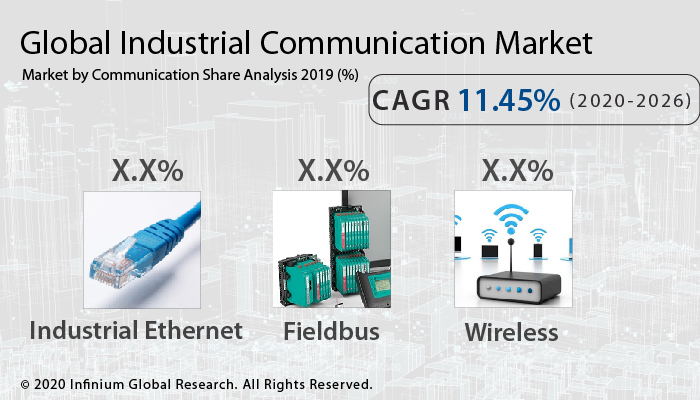Industrial Communication Market (Component - Hardware, Software, and Services; Communication Protocol - Industrial Ethernet, Fieldbus, and Wireless; Application - Automotive and Transportation, Aerospace & Defense, Food & Beverages, Electrical & Electronics, Industrial Manufacturing, and Others): Global Industry Analysis, Trends, Size, Share and Forecasts to 2026
A recent report published by Infinium Global Research on the industrial communication market provides an in-depth analysis of segments and sub-segments in the global as well as regional industrial communication market. The study also highlights the impact of drivers, restraints, and macro indicators on the global and regional industrial communication market over the short term as well as long term. The report is a comprehensive presentation of trends, forecast, and dollar values of the global industrial communication market. According to the report, the global industrial communication market is projected to grow at a CAGR of 11.45% over the forecast period of 2020-2026.
Market Insight
Numerous industry verticals have different requirements on connectivity solutions owing to the harsh environments in which they operate. This leads organizations to adopt different methods of industrial communication. Furthermore, industrial communication is communication between different devices with the help of diverse communication protocols such as industrial Ethernet, wireless, and Fieldbus. This allows for the altercation of data between the devices so that they can communicate. By observing traffic systems and controlling the entire production line it can upsurge productivity. Hence, they are broadly used in industries such as automotive and transportation, food and beverages, aerospace and defense, pharmaceutical, water and wastewater, chemical and fertilizers, and others.
The global industrial communication market is expected to grow at a CAGR of 11.45% between 2020 and 2026 in terms of value. The rising adoption of IoT and the increasing need for interconnectivity between numerous devices and the sharing of data are some of the key growth drivers of the global industrial communication market. Furthermore, the necessity of increasing safety and productivity is also boosting the growth of the market. The augmented adoption of the IoT is likely to make significant changes in the way different products are manufactured, developed, transported, and distributed. Moreover, the growing number of end-user industries, for instance, aerospace, transportation and automotive, defense, paper, cement, energy and power, electrical and electronics, pharmaceutical, oil and gas, food and beverages, mining, glass, fabrication or engineering, water and wastewater, and chemicals and fertilizers will augment the market for industrial communication. On the other hand, data safety and security issues related to wireless communication technology and industrial Ethernet protocols are hampering their adoption among industrial facilities. In addition, the presence of traditional communication technology and a severe industrial environment also retrain the market growth.
The novel coronavirus (COVID-19) pandemic has impacted almost all the industries globally comprising industrial automation and machinery. According to Infinium Global Research’s estimate, in 2020, the industrial communication market will experience a substantial decline owing to the impact of the COVID-19 pandemic. Furthermore, companies are anticipated to increase their capital expenditures on automation over the next year when the global economy recovers. This is projected to decrease the reliance on human labor (workforce) in the long run and is estimated to overcome workforce shortage in the short run.
Geographically, the market for industrial communication is segmented into North America, Europe, Asia Pacific, and the RoW. The North American region is projected to account for the largest share in terms of revenue in this market. This can be accredited to the advancements in technology and prevalence of the Internet of Things in the region coupled with the upsurge in supportive government initiatives and policies etc. Furthermore, the European region currently holds a substantial share and is expected to account for steady growth in this market in the near future owing to the high adoption rate of numerous industry verticals towards advanced technologies, growing government support, and initiatives for the purpose of elimination of barriers and bringing in the adoption of new and advanced digitalization in the region. However, the Asia Pacific region is the fastest-growing region in this market owing to the rapid industrialization in countries comprising India, China, Japan, and Indonesia. Additionally, the increasing adoption of advanced technology and automation, favorable government initiatives, and large-scale development with the use of advanced technologies for manufacturing in the region is anticipated to boost the market growth.

Segment Covered
The report on the global industrial communication market covers segments such as component, communication protocol, and application. On the basis of component, the sub-markets include hardware, software, and services. On the basis of communication protocol, the sub-markets include industrial ethernet, fieldbus, and wireless. On the basis of application, the sub-markets include automotive and transportation, aerospace & defense, food & beverages, electrical & electronics, industrial manufacturing, and others.
Companies Profiled:
The report provides profiles of the companies in the market such as Cisco Systems, Inc., Siemens AG, OMRON Corporation, Rockwell Automation Inc., Mitsubishi Electric Corporation, ABB Ltd, Schneider Electric SE, General Electric Company, Texas Instruments Inc., and Honeywell International Inc.
Report Highlights:
The report provides deep insights into the demand forecasts, market trends, and micro and macro indicators. In addition, this report provides insights into the factors that are driving and restraining the growth in this market. Moreover, The IGR-Growth Matrix analysis given in the report brings an insight into the investment areas that existing or new market players can consider. The report provides insights into the market using analytical tools such as Porter's five forces analysis and DRO analysis of the industrial communication market. Moreover, the study highlights current market trends and provides forecast from 2020-2026. We also have highlighted future trends in the market that will affect the demand during the forecast period. Moreover, the competitive analysis given in each regional market brings an insight into the market share of the leading players.
Request Quote